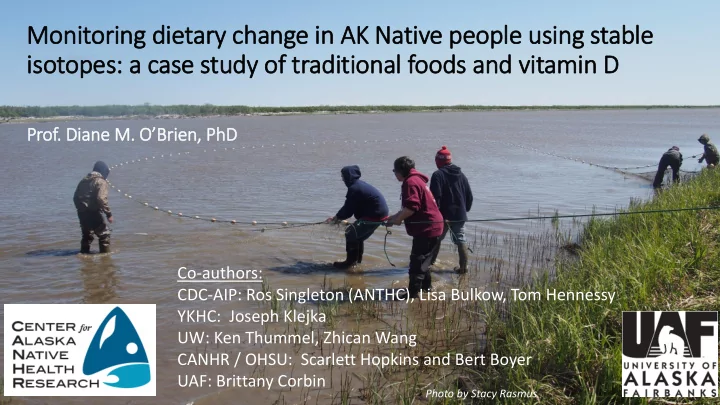

Monitoring die ietary change in in AK Native people using stable is isotopes: a case study of traditional foods and vit itamin D Prof. Diane M. O’Brien, PhD Co-authors: CDC-AIP: Ros Singleton (ANTHC), Lisa Bulkow, Tom Hennessy YKHC: Joseph Klejka UW: Ken Thummel, Zhican Wang CANHR / OHSU: Scarlett Hopkins and Bert Boyer UAF: Brittany Corbin 0 Photo by Stacy Rasmus
All food is is the product of an ecosystem 1
Stable is isotope ratios are ecosystem biomarkers • Naturally occurring • Naturally varying • can be used as tracers 2
d 15 15 N Nitrogen is isotope ratios 18 18- 20‰ 4° consumer (NIR) in in foodwebs 14 14- 17‰ • NIR is elevated in fish and 3° consumer marine mammals 11 11- 13‰ 2° consumer • Great biomarker for traditional foods in YK Delta 8- 10‰ 1° consumer 5- 7‰ 1° producers 3 O’Brien 2015 ARN 35:565 -594
Yup’ik Die iets • Mixed market (~78%) and traditional (~22%) diet • Traditional diet is dominated by fish and marine mammals 4 Bersamin et al 2007 IJCH
NIR in blood and hair is strongly associated with traditional food intake Photo by Stacy Rasmus 5
Biomarker reveals many health-related associations with Yup’ik traditional food intake • Philip et al 2017. PLoS One 12(11): e0183451 • O’Brien et al 2017. Public Health Nutr 20:1738-17. • Age • Au et al 2017. PLoS One PLoS One 12(4): e173616. • Lemas et al 2016. Mol Nutr Food Res 60: 2642-2653 • Language • Aslibekyan et al 2016. Genes Nutr 11:23 • Enculturation • Fohner et al 2016. J Nutr 146(2):318-32. • Vaughan et al. 2015. Metabolism 64: 689-697 • Blood lipids • Beaulieu-Jones et al. 2015. J Nutr 145: 931-938 • Blood pressure • Ryman et al 2015. Br J Nutr 113:634-643 • O’Brien et al. 2014. J Nutr 144:706-713 • Insulin sensitivity • Asklibekyan et al. 2014. J Nutr 1 44: 425-430 • Gene methylation • Klimentidis et al 2014. J Diabetes 6:251-259. • Ryman et al 2014. Public Health Nutr 17:510-518 • Blood clotting • Aslibekyan et al 2013. Am J Hum Biol 25:673-680 • Vitamin D status • Lemas et al 2013. Genes and Nutr 8:495-505 • Lemas et al 2012. J Lipid Res 53:175-184 • Nash et al 2012. J Nutr 142: 84-90. 6
Monitoring die ietary change: the “Nutrition Transition” • We know it has happened – is it still happening? When were the key times of change? • How does timing relate to increased incidence of rickets in AN infants/children? (Singleton et al 2015) • Used the Alaska Area Specimen Bank (CDC) • Serum specimens dating back to early 1960’s • 20-29 y.o. women from YK Delta • N = 25 per decade 7
Quantifying the “Nutrition Transition” Precipitous decline in fish/marine Associated with poorer vitamin D mammal intake from the 1960s 1990s status in young women Coastal Inland 8 O’Brien et al. 2017 PHN 20:1738 -1745
9
Summary • Traditional food intake by young, YKD women dropped from the 1960’s through the 1990’s • Associated with changes in vitamin D status • Unprecedented record of dietary change spanning over 60 years • Ecosystem tools (stable isotopes) + biorepository • Translated into public health policy • We would love to apply these tools to other questions relating to dietary change 10
Establi lished in in 2001 to address Ala laska Nativ ive health prio ioritie ies through community-engaged research • Cult lturall lly rele levant, strengths-based in intervention research Tribally-driven suicide and substance abuse prevention Programs to strengthen traditional food systems • Epid idemiologic ic research How genes, diet and physical activity relate to risk factors for obesity, CVD, metabolic syndrome, and vitamin D deficiency • Methodological research Resilience, well-being and strengths-based approaches to the reduction of health disparities Developing tools to monitor food systems and dietary change 11
Recommend
More recommend